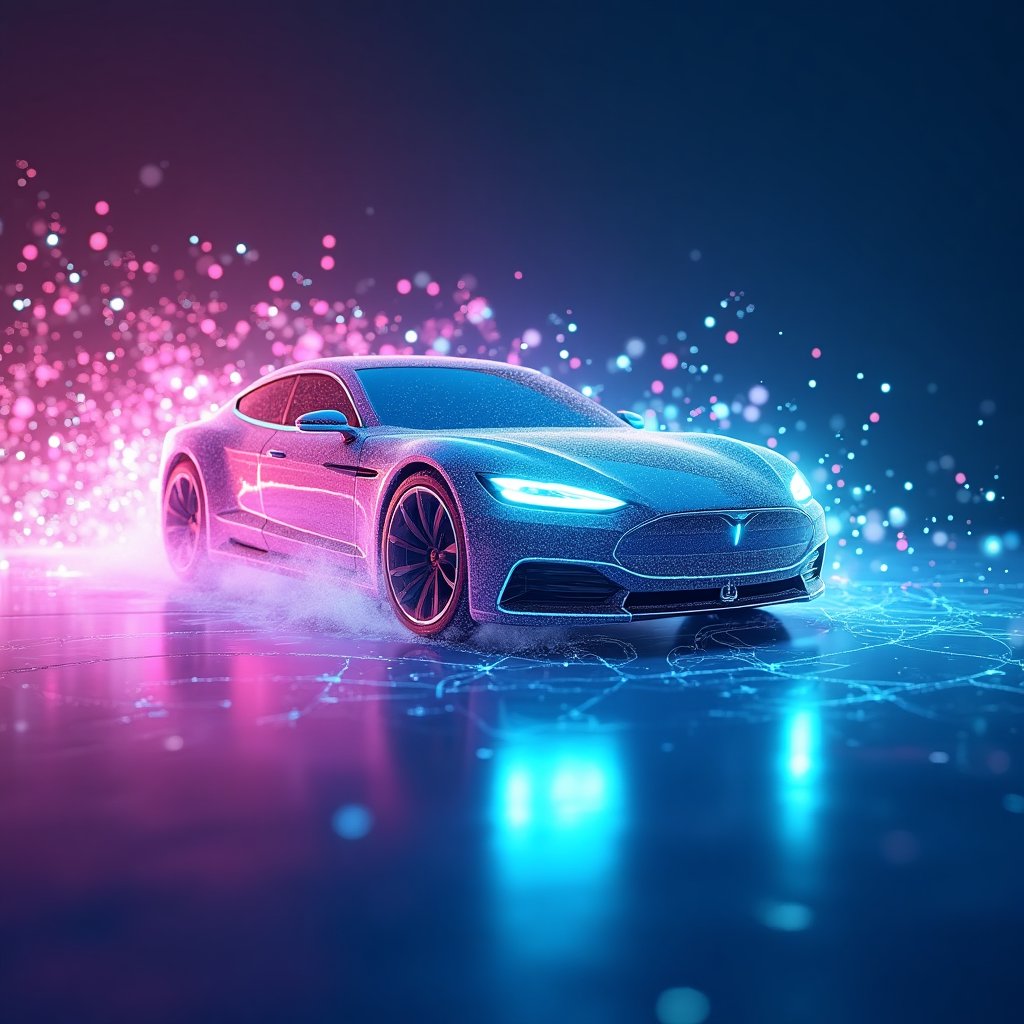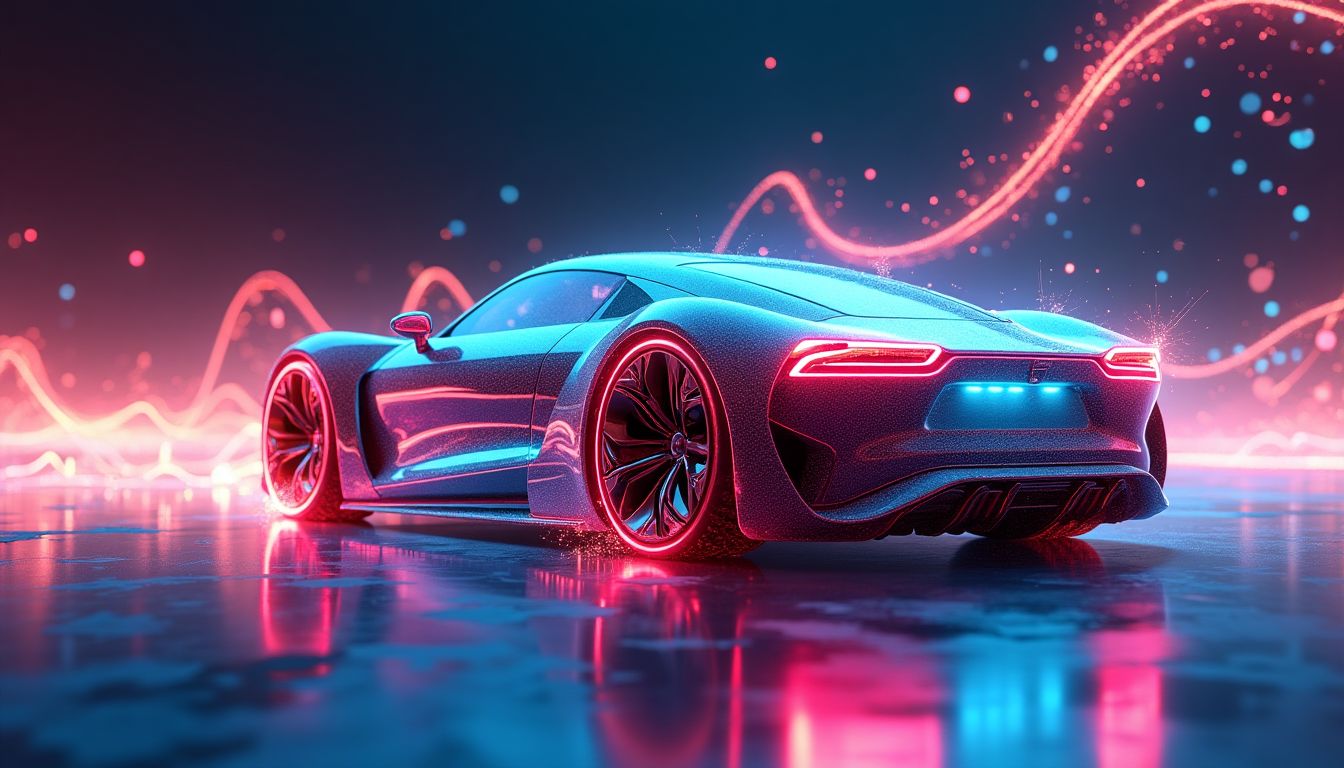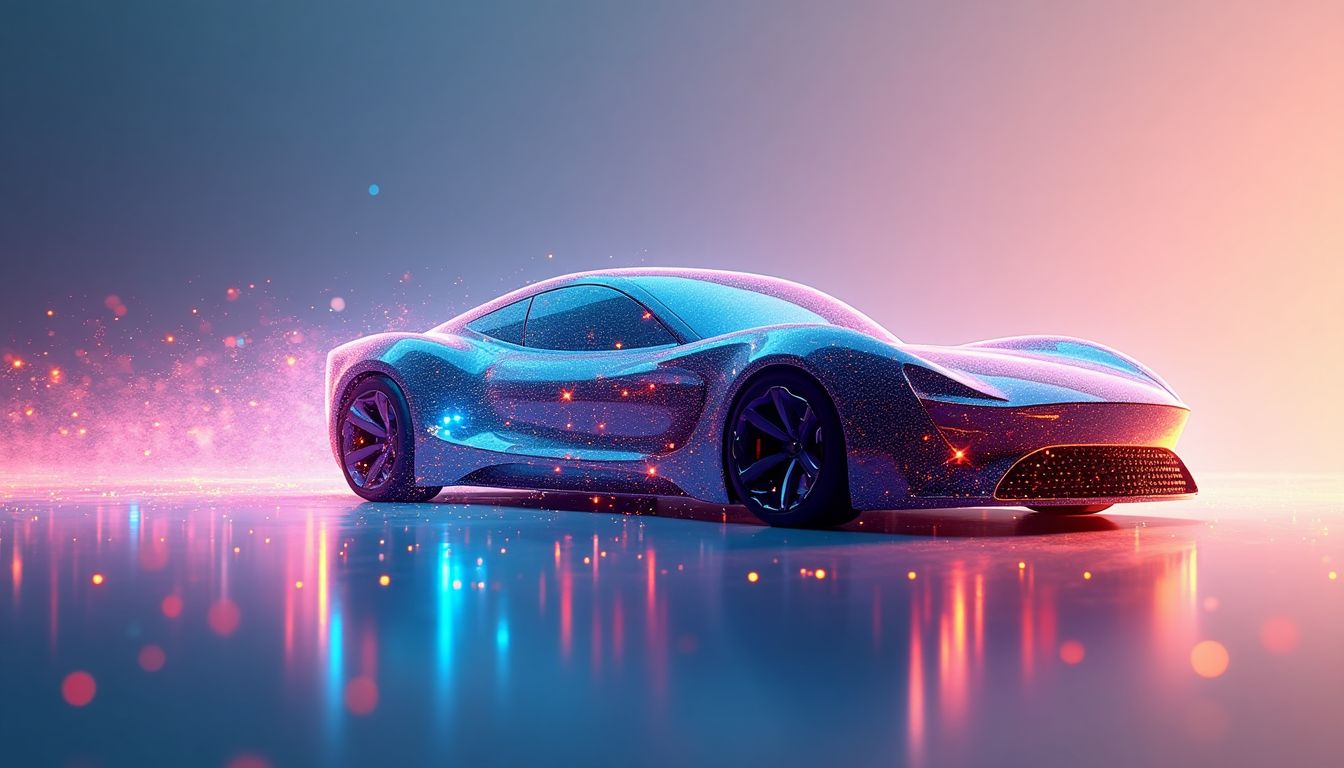What if the car of the future didn’t just run on electricity or gasoline but was powered by the mind-bending principles of quantum mechanics? A vehicle that could travel thousands of miles on a single charge, adapt to road conditions in real-time, and even repair itself using AI-driven systems. Sounds like something out of a sci-fi movie, right? But this isn’t fiction—it’s the future of automotive power, and it’s closer than you think.
The automotive industry is no stranger to innovation. From the invention of the internal combustion engine to the rise of electric vehicles (EVs), we’ve seen it all. But the next big leap? Quantum-powered engines. These engines, driven by the principles of quantum mechanics and optimized by artificial intelligence (AI), could redefine what it means to drive. Think unparalleled energy efficiency, self-learning systems, and vehicles that outperform anything on the road today.
Renowned physicist Michio Kaku once said, “The quantum theory is the DNA of the universe.” And he’s not wrong. Quantum mechanics, with its principles of superposition, entanglement, and tunneling, holds the key to unlocking a new era of energy. Add AI into the mix, and you’ve got a recipe for a transportation revolution. Even Elon Musk, the visionary behind Tesla, has hinted at the potential of quantum computing in automotive applications. Meanwhile, Sabine Hossenfelder, a theoretical physicist, has explored how quantum mechanics could transform energy systems in her research.
This article dives into the intersection of quantum mechanics, AI, and automotive engineering. We’ll explore how AI could unlock the potential of quantum-powered vehicles, the challenges that lie ahead, and a step-by-step roadmap to make this vision a reality. Buckle up—this is the future of transportation.
1. The Quantum Revolution in Automotive Power
1.1 What is a Quantum Engine?
At its core, a quantum engine is a propulsion system that leverages the principles of quantum mechanics to generate and manage energy. But what does that even mean? Let’s break it down. Quantum mechanics is the branch of physics that deals with the behavior of particles at the atomic and subatomic levels. It’s weird, it’s wild, and it’s nothing like the physics you learned in high school.
Key principles of quantum mechanics include:
- Superposition: A quantum particle can exist in multiple states at once until it’s observed. Think of it like Schrödinger’s cat—both alive and dead until you open the box.
- Entanglement: Two particles can become linked, so that the state of one instantly affects the state of the other, no matter how far apart they are. It’s like having a cosmic twin.
- Tunneling: Particles can “tunnel” through barriers that would be impossible to cross in classical physics. It’s like walking through a wall—Harry Potter style.
Now, imagine applying these principles to a car engine. Instead of burning fuel or relying on lithium-ion batteries, a quantum engine could harness these quantum phenomena to generate energy more efficiently. For example, quantum tunneling could allow electrons to move through energy barriers with minimal resistance, drastically improving energy efficiency. And entanglement could enable instant communication between different parts of the engine, optimizing performance in real-time.
Compared to traditional combustion engines and electric motors, quantum engines promise unprecedented energy density and efficiency. While a Tesla Model S can travel about 400 miles on a single charge, a quantum-powered vehicle could theoretically go thousands of miles without needing to refuel or recharge. It’s like upgrading from a bicycle to a rocket ship.
1.2 Why Quantum Power?
So, why should we care about quantum-powered vehicles? For starters, they could revolutionize energy efficiency. Traditional engines waste a lot of energy as heat, but quantum engines could minimize this loss, making them far more efficient. Plus, they could operate with zero emissions, helping to combat climate change.
But the benefits don’t stop there. Quantum power could also enable new applications beyond cars. Imagine drones that can fly for days without recharging, or aircraft that can travel across the globe on a single tank of quantum fuel. Even space exploration could benefit, with quantum-powered rockets making interstellar travel a reality.
And let’s not forget the environmental impact. Quantum engines could reduce our reliance on fossil fuels and rare earth materials like lithium, which are used in traditional batteries. Instead, they could harness energy from renewable sources like solar or wind, making them a sustainable option for the future.
1.3 Current Research and Breakthroughs
While quantum-powered vehicles might sound like science fiction, significant progress is already being made. Companies like IBM, Google Quantum, and D-Wave are leading the charge in quantum computing, which is closely related to quantum energy systems. These companies are developing quantum processors that could one day power everything from cars to smartphones.
Automotive giants like Tesla and Toyota are also exploring the potential of quantum technology. Tesla, for example, has been investing heavily in AI and could leverage quantum computing to optimize its self-driving systems. Meanwhile, Toyota is researching quantum batteries, which could store energy more efficiently than traditional lithium-ion batteries.
One exciting breakthrough is the development of quantum sensors, which could be used to monitor and optimize engine performance in real-time. These sensors could detect even the slightest changes in temperature, pressure, or vibration, allowing the engine to adjust itself for maximum efficiency. It’s like having a mechanic inside your car, constantly fine-tuning the engine.
But perhaps the most promising area of research is quantum energy storage. Traditional batteries lose energy over time, but quantum systems could store energy indefinitely, thanks to the principles of superposition and entanglement. This could lead to batteries that never degrade, making them ideal for long-term use in vehicles.
2. The Role of AI in Quantum-Powered Vehicles
2.1 AI as the Brain of Quantum Engines
Imagine your car not just as a machine, but as a living, breathing entity that learns and adapts. That’s the magic of AI in quantum-powered vehicles. Artificial intelligence acts as the brain, optimizing quantum energy systems in real-time. Think of it as a super-smart co-pilot that’s always one step ahead. AI uses machine learning algorithms to manage energy distribution, ensuring your car runs smoother, faster, and more efficiently than ever before. It’s like having a personal trainer for your vehicle, but instead of burpees, it’s crunching numbers and solving quantum equations.
For example, companies like IBM and Google Quantum AI are already exploring how AI can enhance quantum systems. By integrating AI with quantum mechanics, we’re not just building cars—we’re creating intelligent machines that can think for themselves.
2.2 Self-Learning Systems
What if your car could learn your driving habits and adjust itself accordingly? With AI-driven self-learning systems, this isn’t just possible—it’s inevitable. These systems use data from your driving patterns, weather conditions, and even road quality to optimize performance. Forgot to check your tire pressure? No worries, your car’s AI has already predicted it and adjusted the suspension for a smoother ride.
Predictive maintenance is another game-changer. AI can analyze data from quantum sensors to detect potential issues before they become problems. It’s like having a mechanic living inside your car, but without the awkward small talk. Companies like Tesla are already using AI for predictive maintenance in their electric vehicles, and the results are impressive.
2.3 Integration with Autonomous Driving
Now, let’s talk about the ultimate dream: self-driving cars powered by quantum engines. The synergy between quantum-powered engines and autonomous driving AI systems is a match made in tech heaven. AI can make split-second decisions based on real-time data, ensuring your car navigates safely and efficiently. Imagine cruising down the highway while your car handles everything—lane changes, speed adjustments, and even avoiding that pesky pothole you didn’t see.
Companies like Waymo and Cruise are leading the charge in autonomous driving. By integrating quantum-powered engines, these vehicles could achieve levels of efficiency and safety that were previously unimaginable. It’s not just about getting from point A to point B—it’s about doing it smarter, faster, and cleaner.
3. Challenges in Developing Quantum-Powered Vehicles
3.1 Technical Hurdles
As exciting as quantum-powered vehicles sound, they come with their fair share of challenges. One of the biggest hurdles is the stability and scalability of quantum systems. Quantum mechanics is notoriously finicky, and maintaining a stable quantum state in a moving vehicle is no small feat. Plus, quantum systems often require extreme cooling, which adds another layer of complexity. Imagine trying to keep your car’s engine at near-absolute zero temperatures while driving through a desert—sounds like a sci-fi plot, right?
Another challenge is integrating quantum systems with existing automotive technologies. It’s like trying to fit a square peg into a round hole, but with more math and fewer hammers. Researchers at institutions like MIT and Caltech are working tirelessly to overcome these obstacles, but there’s still a long way to go.
3.2 Economic and Industrial Barriers
Let’s talk money. Developing quantum-powered vehicles isn’t cheap. The costs of quantum research and development are astronomical, and transitioning from traditional manufacturing to quantum-based production is a massive undertaking. It’s like trying to build a spaceship with a budget meant for a bicycle. Companies like Toyota and BMW are investing heavily in quantum research, but it’s going to take a collective effort from the entire industry to make this vision a reality.
Another economic barrier is the potential disruption to existing markets. Traditional car manufacturers and oil companies might not be too thrilled about a technology that could render their products obsolete. It’s a classic case of innovation vs. tradition, and the stakes are high.
3.3 Regulatory and Safety Concerns
Safety is always a top priority, especially when it comes to new technologies. Ensuring the safety of quantum-powered vehicles is a monumental task. Regulatory bodies like the National Highway Traffic Safety Administration (NHTSA) will need to develop new frameworks to oversee these vehicles. It’s not just about making sure the car works—it’s about making sure it’s safe for everyone on the road.
Another concern is the potential for misuse. Quantum-powered vehicles could be incredibly powerful, and with great power comes great responsibility. Ensuring that these vehicles are used ethically and responsibly is crucial. It’s like giving a teenager the keys to a supercar—exciting, but also a little terrifying.
4. The Environmental Impact of Quantum-Powered Vehicles
4.1 Sustainability Benefits
Imagine a world where cars don’t just run on clean energy but are so efficient that they leave no carbon footprint at all. Quantum-powered vehicles could make this dream a reality. Unlike traditional combustion engines or even current electric vehicles (EVs), quantum engines could operate with zero emissions. This isn’t just about reducing pollution—it’s about eliminating it entirely. For example, quantum batteries, which leverage principles like superposition and entanglement, could store energy more efficiently than lithium-ion batteries, reducing waste and energy loss.
But the benefits don’t stop there. Quantum-powered vehicles could also integrate seamlessly with renewable energy sources like solar and wind. Imagine your car charging itself using solar panels embedded in its surface or drawing power from a wind turbine network. This isn’t just a step forward—it’s a leap toward a sustainable future. Companies like Tesla and Toyota are already exploring quantum-inspired technologies, and the potential for global impact is enormous.
4.2 Resource Efficiency
One of the biggest challenges with current EVs is their reliance on rare earth materials like lithium, cobalt, and nickel. Mining these materials is not only expensive but also environmentally damaging. Quantum-powered vehicles could change the game by reducing or even eliminating the need for these materials. Quantum energy systems, such as quantum batteries, could use more abundant and less harmful materials, making them both cost-effective and eco-friendly.
Here’s a quick comparison of traditional lithium-ion batteries versus quantum batteries:
| Feature | Lithium-Ion Batteries | Quantum Batteries |
|---|---|---|
| Energy Density | High | Extremely High |
| Material Use | Rare earth metals (lithium, cobalt) | Abundant materials |
| Environmental Impact | High (mining, waste) | Low to None |
Additionally, quantum-powered systems could last longer and be more recyclable, reducing waste and conserving resources. This isn’t just good for the planet—it’s good for your wallet too.
4.3 Global Implications
The impact of quantum-powered vehicles goes beyond individual cars. On a global scale, this technology could help combat climate change by drastically reducing greenhouse gas emissions. According to the Intergovernmental Panel on Climate Change (IPCC), transportation accounts for nearly a quarter of global CO2 emissions. Quantum-powered vehicles could slash this number, helping countries meet their sustainability goals under agreements like the Paris Agreement.
Moreover, quantum-powered transportation could enhance energy independence. Countries that rely heavily on oil imports could transition to self-sufficient energy systems powered by quantum technology. This shift could reshape global politics, reduce conflicts over resources, and create a more stable world.
5. The Future of Quantum-Powered Transportation
5.1 Beyond Cars: Quantum-Powered Everything
While cars are the most obvious application, quantum-powered technology could revolutionize other forms of transportation too. Imagine quantum-powered airplanes that fly farther and faster with zero emissions. Or ships that cross oceans using quantum energy systems, reducing their environmental impact. Even public transportation could benefit, with quantum-powered buses and trains offering cleaner, more efficient travel.
Here are some potential applications:
- Aviation: Quantum-powered aircraft could reduce fuel consumption and emissions, making air travel more sustainable.
- Shipping: Quantum engines could power cargo ships, reducing their reliance on fossil fuels.
- Public Transit: Quantum-powered buses and trains could offer faster, cleaner commutes.
- Drones: Quantum-powered drones could deliver packages with unprecedented efficiency.
Companies like Boeing and Airbus are already exploring quantum-inspired technologies for aviation, and the possibilities are endless.
5.2 Economic and Social Transformation
The rise of quantum-powered transportation could create millions of jobs in fields like quantum engineering, AI development, and renewable energy. According to a report by the World Economic Forum, the green energy sector could create 24 million new jobs by 2030. Quantum-powered vehicles could be a major driver of this growth.
But the impact goes beyond jobs. Quantum-powered transportation could transform urban planning and infrastructure. Cities could become cleaner, quieter, and more efficient, with less traffic congestion and pollution. This could improve quality of life for millions of people, making cities more livable and sustainable.
5.3 Ethical Considerations
As with any transformative technology, quantum-powered transportation raises important ethical questions. How do we ensure that everyone has access to this technology, not just the wealthy? How do we prevent misuse of quantum-AI systems, such as hacking or surveillance? These are complex issues that require careful consideration.
One solution is to develop policies that promote equitable access to quantum-powered transportation. Governments could offer subsidies or incentives to make these vehicles affordable for everyone. Additionally, robust cybersecurity measures will be essential to protect quantum-AI systems from malicious actors.
The future of transportation is quantum-powered, and it’s up to us to shape it in a way that benefits everyone. What kind of world do you want to live in? The choice is ours.
6. AI Solutions: How Would AI Tackle This Issue?
6.1 Step 1: Data Collection and Simulation
To build a quantum-powered vehicle, the first step is gathering and analyzing massive amounts of data. AI can model quantum systems by simulating their behavior under various conditions. Companies like IBM Quantum and Google Quantum AI are already using quantum simulators to test hypotheses. AI can process this data to identify patterns and predict how quantum systems will perform in real-world scenarios. Think of it as teaching a car to "think" before it even hits the road.
6.2 Step 2: Optimization Algorithms
Once the data is collected, AI can develop optimization algorithms to fine-tune energy transfer and storage in quantum systems. Reinforcement learning, a subset of machine learning, can be used to improve system efficiency. For example, AI could determine the optimal energy distribution for a quantum-powered car traveling uphill versus downhill. This step is crucial for ensuring that quantum engines outperform traditional combustion and electric engines in every scenario.
6.3 Step 3: Real-Time Adaptation
Quantum-powered vehicles will need to adapt to real-time conditions, such as weather, traffic, and road quality. AI-driven control systems can make split-second adjustments to optimize performance. Quantum sensors, which are far more sensitive than traditional sensors, can feed data into AI models to enable real-time decision-making. Imagine a car that adjusts its energy usage based on the road ahead—AI makes this possible.
6.4 Step 4: Collaboration with Quantum Hardware
AI alone isn’t enough; it needs to work hand-in-hand with quantum hardware. Partnering with companies like D-Wave and Rigetti Computing can help integrate AI with quantum processors. Hybrid systems that combine classical and quantum computing could be the key to unlocking the full potential of quantum-powered vehicles. This collaboration will ensure that AI and quantum mechanics work seamlessly together.
6.5 Step 5: Scaling and Deployment
The final step is scaling the technology for mass production. AI can identify the most viable applications for quantum-powered vehicles, such as urban transportation or long-haul trucking. It can also streamline manufacturing processes by using machine learning for quality control. Companies like Tesla and Toyota could lead the charge in bringing quantum-powered vehicles to market. AI will ensure that these vehicles are not only efficient but also affordable and accessible.
Action Schedule/Roadmap
Day 1: Assemble a multidisciplinary team of quantum physicists, AI experts, and automotive engineers. Include representatives from leading institutions like MIT and Caltech to ensure a diverse skill set.
Day 2: Begin data collection on existing quantum energy systems and automotive technologies. Use AI to analyze historical data from electric vehicles and quantum experiments.
Week 1: Develop a quantum simulation framework using AI. Leverage tools like Qiskit and Cirq to create accurate models.
Week 2: Conduct initial simulations to identify key challenges and opportunities. Use AI to predict how quantum systems will perform under different conditions.
Month 1: Build a prototype quantum energy system for testing. Collaborate with companies like Lockheed Martin to access advanced manufacturing facilities.
Month 2: Integrate AI algorithms into the prototype for optimization. Use reinforcement learning to improve energy efficiency and performance.
Year 1: Test the prototype in controlled environments and gather data. Partner with universities like Stanford to conduct rigorous testing.
Year 1.5: Scale up the system for use in small vehicles, such as drones. Work with companies like DJI to integrate quantum-powered engines into their products.
Year 2: Launch a pilot program for quantum-powered vehicles in select cities. Collaborate with governments and urban planners to ensure a smooth rollout.
The Quantum Future: A New Era of Transportation
The fusion of quantum mechanics and AI isn’t just a technological leap—it’s a cultural and societal revolution. Imagine a world where cars don’t just take you from point A to point B but do so with unparalleled efficiency, intelligence, and environmental responsibility. Quantum-powered vehicles could redefine our relationship with transportation, turning it into a seamless, sustainable, and even enjoyable experience.
But this future isn’t just about cars. It’s about reimagining how we move, live, and interact with the world around us. From quantum-powered drones delivering groceries to self-healing roads that adapt to traffic patterns, the possibilities are endless. And at the heart of it all is AI, the invisible force that makes this vision possible.
As we stand on the brink of this new era, one question remains: Are we ready to embrace the quantum future? The technology is within our grasp, but it will take collaboration, innovation, and a willingness to challenge the status quo. The road ahead is long, but the destination is worth it. The future is quantum—and it’s closer than you think.
What do you think about the potential of quantum-powered vehicles? Could this be the solution to our transportation woes, or are there hurdles we’re not yet prepared to overcome? Share your thoughts in the comments below, and don’t forget to subscribe to our newsletter for more insights into the future of technology. Become a permanent resident of iNthacity: the "Shining City on the Web" and join the conversation!
FAQ
Q1: What is a quantum engine?
A quantum engine is a futuristic propulsion system that uses the principles of quantum mechanics to generate and manage energy. Unlike traditional engines that rely on burning fuel or storing electricity, quantum engines tap into the strange and powerful behaviors of particles at the atomic level. Think of it as harnessing the same forces that power stars and atoms to move your car!
Q2: How does AI fit into quantum-powered vehicles?
AI acts as the brain of quantum-powered vehicles. It helps optimize energy use, adapt to road conditions, and even predict when parts might need maintenance. For example, companies like IBM and Google Quantum AI are already using AI to make quantum systems smarter and more efficient. In a car, AI could analyze data from quantum sensors in real-time to ensure you’re getting the most out of your engine.
Q3: Are quantum-powered vehicles safe?
Safety is a top priority for any new technology. While quantum-powered vehicles are still in the experimental stage, researchers are working hard to ensure they’re as safe as traditional cars. For instance, Tesla and Toyota are already testing advanced safety features in their electric and autonomous vehicles. Quantum-powered cars would likely go through even more rigorous testing before hitting the road.
Q4: When can we expect quantum-powered vehicles on the road?
It might take a while before you see a quantum-powered car in your driveway. Experts estimate it could be 10 to 15 years before this technology becomes mainstream. However, companies like D-Wave and Rigetti Computing are making rapid progress in quantum research. So, while it’s not around the corner, it’s definitely on the horizon.
Q5: What are the environmental benefits of quantum-powered vehicles?
Quantum-powered vehicles could be a game-changer for the environment. Here’s why:
- Zero Emissions: Unlike gasoline engines, quantum engines could produce no harmful emissions.
- Energy Efficiency: Quantum systems are incredibly efficient, meaning less energy is wasted.
- Renewable Integration: These vehicles could work seamlessly with renewable energy sources like solar and wind power.
For example, U.S. Department of Energy is already exploring how quantum technology can help reduce our carbon footprint.
Q6: Who are the key players working on quantum-powered vehicles?
Several big names in tech and automotive are diving into quantum research. Here are a few:
- IBM: A leader in quantum computing research.
- Google Quantum AI: Pioneering quantum algorithms and hardware.
- Tesla: Known for pushing the boundaries of electric vehicles.
- Toyota: Investing in next-gen automotive technologies.
Q7: How do quantum-powered vehicles compare to electric vehicles (EVs)?
Quantum-powered vehicles could outperform EVs in several ways:
| Feature | Electric Vehicles (EVs) | Quantum-Powered Vehicles |
|---|---|---|
| Energy Source | Batteries (lithium-ion) | Quantum systems (superposition, entanglement) |
| Range | 300-400 miles per charge | Potentially thousands of miles |
| Charging Time | 30 minutes to several hours | Near-instantaneous |
While EVs are a great step forward, quantum-powered vehicles could take things to a whole new level.
Q8: What challenges are holding back quantum-powered vehicles?
There are a few big hurdles to overcome:
- Technical Challenges: Quantum systems are incredibly complex and often require extreme cooling to function.
- Cost: Developing quantum technology is expensive, and scaling it up for mass production will take time.
- Regulations: Governments will need to create new rules to ensure these vehicles are safe for the road.
Despite these challenges, researchers are making steady progress. For example, NIST is working on standards for quantum technology.
Q9: Could quantum-powered vehicles work in space?
Absolutely! Quantum technology could revolutionize space travel. For instance, NASA is already exploring how quantum computing could improve spacecraft navigation and communication. Quantum-powered engines could make interstellar travel faster and more efficient, opening up new possibilities for exploring the cosmos.
Q10: How can I learn more about quantum-powered vehicles?
If you’re curious about the future of transportation, there are plenty of resources to explore. Check out iNthacity’s blog for more articles on cutting-edge tech. You can also follow companies like IBM and Google Quantum AI to stay updated on the latest breakthroughs.
Got more questions? Drop them in the comments below, and let’s keep the conversation going!
Wait! There's more...check out our gripping short story that continues the journey: X-23 Quantum Corsair
Disclaimer: This article may contain affiliate links. If you click on these links and make a purchase, we may receive a commission at no additional cost to you. Our recommendations and reviews are always independent and objective, aiming to provide you with the best information and resources.
Get Exclusive Stories, Photos, Art & Offers - Subscribe Today!





























1 comment